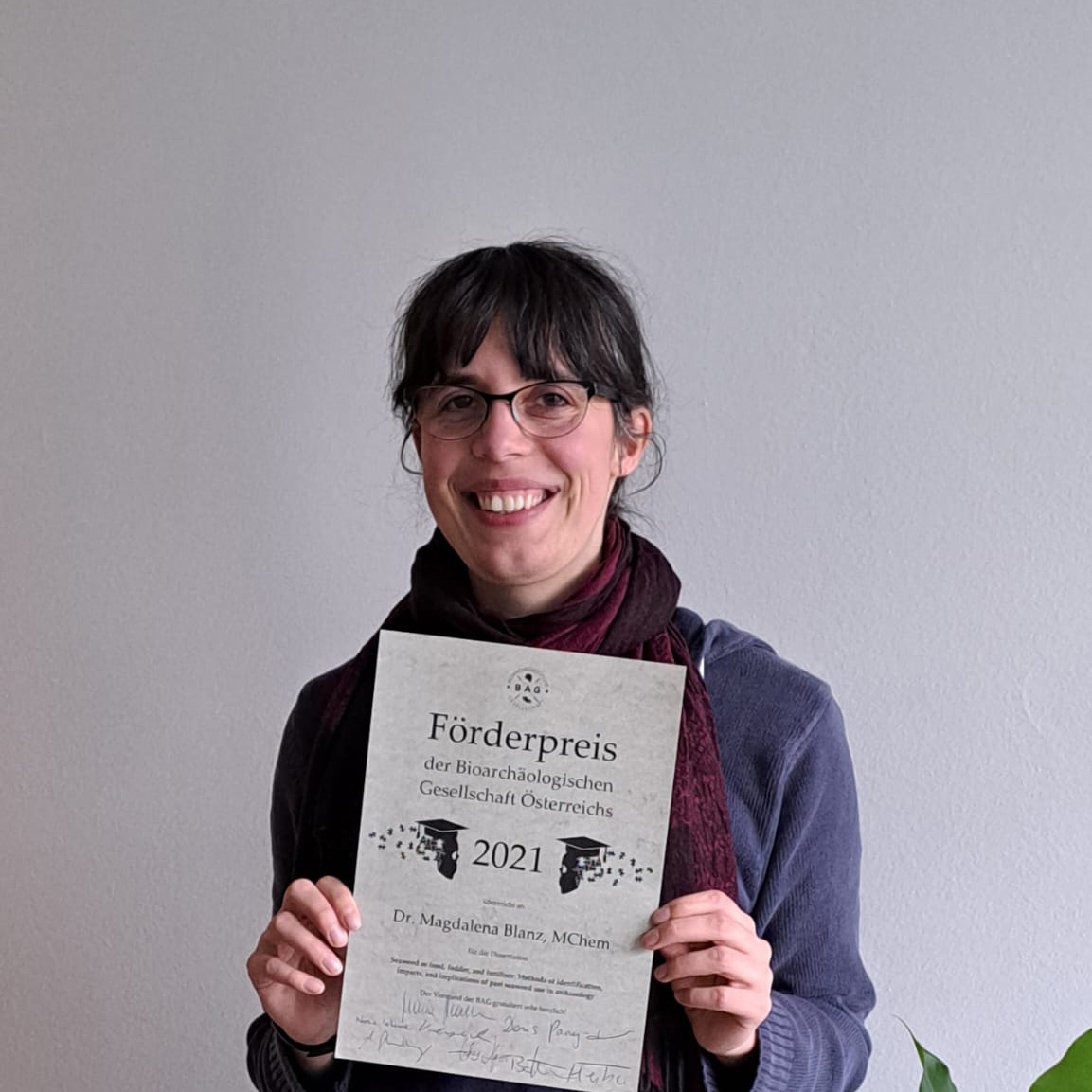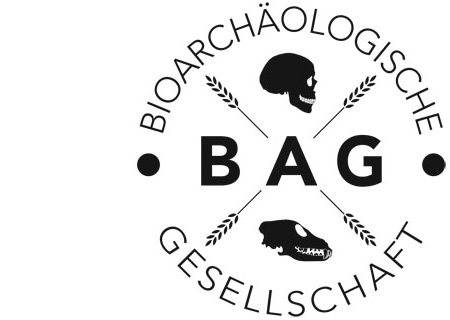
- Diese Veranstaltung hat bereits stattgefunden.
Livestream
Verleihung des BAG-Förderpreises 2021, Kategorie Dissertation
13. Dezember 2022 @ 18:30 - 19:15 CET

Der zweite BAG-Förderpreis 2021 für Dissertationen wurde heute an Dr. Magdalena Blanz, MChem, VIAS der Universität Wien, verliehen. Der Vorstand der BAG gratuliert aufs Herzlichste!
Titel der Abschlussarbeit
Seaweed as food, fodder, and fertiliser: Methods of identification, impacts, and implications of past seaweed use in archaeology
Abstract
| Trotz zahlreicher historischer und ökologischer Belege für den absichtlichen Verzehr von Meeresalgen durch Wild- und Haustiere (z. B. Hirsche, Kojoten, Schafe, Rinder) wird Meeresalgen als potenzielle Nahrungsquelle bei archäologischen Interpretationen oft vernachlässigt. Die Untersuchung von Seegras als Nahrungsquelle für domestizierte Tiere bietet eine einzigartige Gelegenheit, die Entwicklung der lokalen Anpassung an die Küstenumwelt zu untersuchen und die frühere Landnutzung und den Zugang zu ihr zu erforschen. Durch die Analyse des Verhältnisses der stabilen Kohlenstoffisotope (δ13C) von Skelettmaterial können direkte Beweise für den Verzehr von Meeresalgen gewonnen werden. Allerdings sind die derzeitigen Interpretationen durch das Fehlen moderner δ13C-Referenzdaten von Kollagen für Algen fressende Tiere eingeschränkt worden. Außerdem kann eine gemischte Ernährung mit C3- und C4-Pflanzen zu ähnlichen δ13C-Werten führen wie der Verzehr von Algen, was den Nutzen der δ13C-Analyse in diesem Zusammenhang einschränkt. In dieser Studie wurden moderne Zähne und Knochen von Seegras und Gras fressenden Schafen von den Orkney-Inseln (Schottland) sowie moderne Vegetationsproben auf δ13C und δ15N im Kollagen sowie auf Spurenelementverhältnisse (Ba/Sr, Sr/Ca, Ba/Ca, V/Ca und U/Ca) untersucht. Die Ergebnisse zeigten, dass die Algen fressenden Schafe deutlich höhere δ13C-Werte und niedrigere Ba/Sr-Verhältnisse aufwiesen als grasfressende Schafe. Die Ergebnisse dieser Referenzpopulation verbessern das derzeitige Verständnis der Kollagen-δ13C-Daten bereits veröffentlichter und künftiger Studien und zeigen außerdem das Potenzial von Spurenelementverhältnissen zur Identifizierung des Algenkonsums in Gebieten, in denen sowohl C4- als auch C3-Pflanzen vorhanden sind. Um die Auswirkungen der Düngung von Getreide mit Algen auf die Konzentrationen von δ13C, δ15N und Spurenelementen zu untersuchen, wurde ein Feldversuch auf den Orkney-Inseln durchgeführt. Die lokale Gerstenlandrasse Bere wurde nach historisch belegten Praktiken mit Algen ausgesät und gedüngt. Die Analyse der gedüngten und ungedüngten Gerste zeigte, dass eine einmalige Düngung mit Algen die δ13C-Werte nicht signifikant beeinflusste, aber die δ15N-Werte und Sr-Konzentrationen erhöhte. Die Düngung mit Seetang erschwert daher wahrscheinlich die Identifizierung des Seetangverzehrs, wenn man sich auf die Ba/Sr-Verhältnisse im Schmelz stützt. Außerdem können die Auswirkungen auf δ15N die Untersuchung der trophischen Ebene bei Konsumenten von mit Algen gedüngten Pflanzen im Vergleich zu Konsumenten von ungedüngten Pflanzen erschweren. Schließlich wurden die entwickelten Methoden auf Zähne von Schafen und Hirschen angewandt, die hauptsächlich aus dem neolithischen Ness of Brodgar (Orkney) stammen. Sequentielle Schmelzproben wurden auch auf δ13C und δ18O analysiert, und es wurden Profile der Herdensterblichkeit auf der Grundlage der Zahnabnutzung erstellt. Drei der 17 auf δ13C untersuchten Schafzähne wiesen erhöhte δ13C-Werte auf, die auf den Verzehr von Algen hinweisen. Im Gegensatz dazu wies keines der untersuchten Hirsche messbare Anzeichen für den Verzehr von Algen auf, was auf Unterschiede in der Ernährung von Schafen und Hirschen hinweist, die möglicherweise auf anthropogene Einflüsse zurückzuführen sind. Die Ergebnisse dieser Arbeit deuten darauf hin, dass der Verzehr von Seetang in der Vergangenheit in Küstengebieten weiter verbreitet war als gemeinhin angenommen. | Despite plentiful historical and ecological evidence of the voluntary consumption of seaweeds by wild and domesticated animals (e.g. deer, coyotes, sheep, cattle), seaweed is often neglected as a potential food source in archaeological interpretations. The study of seaweed as a food source for domesticated animals offers a unique opportunity to investigate the development of local adaptation to the coastal environment, and to study past land use and access. By analysing stable carbon isotope ratios (δ13C) of skeletal material, direct evidence of seaweed consumption may be gained. However, current interpretations have been restricted by the lack of modern reference collagen δ13C data for seaweed-eating animals. Additionally, mixed diets of terrestrial C3 and C4 plants may result in similar δ13C values as seaweed consumption, limiting the usefulness of δ13C analysis in this context. In this study, modern teeth and bones from seaweed- and grass-eating sheep from the Orkney Islands (Scotland), as well as modern vegetation samples, were analysed for collagen δ13C and δ15N, and trace element ratios (Ba/Sr, Sr/Ca, Ba/Ca, V/Ca and U/Ca). The results showed the seaweed-eating sheep to have significantly higher δ13C values and lower Ba/Sr ratios than grass-eating sheep. The results of this reference population improve present understanding of collagen δ13C data of already published and future studies, and also show the potential of trace element ratios to enable the identification of seaweed consumption in areas where both C4 and C3 plants are present. To study the effect of fertilisation of cereals with seaweed on δ13C, δ15N and trace element concentrations, a field trial was conducted on the Orkney Islands. The local barley landrace Bere was sown and fertilised with seaweed according to historically attested practices. Analysis of the fertilised and unfertilised barley showed that a one-time fertilisation with seaweed did not affect δ13C values significantly, but elevated δ15N values and Sr concentrations. Fertilisation with seaweed thus likely complicates the identification of seaweed consumption when relying on enamel Ba/Sr ratios. Additionally, effects on δ15N can complicate the study of trophic level in consumers of plants fertilised with seaweed compared to consumers of unfertilised crops. Lastly, the developed methods were applied to sheep and deer teeth mainly originating from the Neolithic Ness of Brodgar (Orkney). Sequential enamel samples were also analysed for δ13C and δ18O, and herd mortality profiles based on tooth wear were created. Three of the 17 sheep teeth analysed for δ13C showed elevated δ13C values indicative of seaweed-consumption. In contrast, none of the analysed deer showed measurable evidence of seaweed-consumption, indicating dietary differences between sheep and deer that may be due to anthropogenic influences. The results of this thesis indicate that past seaweed consumption may have been more prevalent in coastal areas than commonly assumed. |
Details
- Datum:
- 13. Dezember 2022
- Zeit:
-
18:30 - 19:15 CET
- Veranstaltungskategorien:
- foerderpreis, intern
Veranstaltungsort
- online
Veranstalter
- Bioarchäologische Gesellschaft Österreichs
- info@bag.or.at
- Veranstalter-Website anzeigen
